Our tour ran from Sunday 4th to Friday 9th September, 2022.
Our first proper bush walk was Monday morning on the Sandstone Caves walk in Pilliga Nature Reserve. Botanising commenced immediately with delegates stepping off the bus into a carpark adjoining bushland. Here we picked up Aotus mollis, Zieria aspalathoides (Hairy / Heath Zieria) and Bossiaea neoanglica, as well as Pultenaea cinerascens (Cluster-leaf Bush Pea). We identified the small trees present which were Corymbia trachyphloia (White Bloodwood) and Eucalyptus crebra (Narrow-leaved Ironbark).
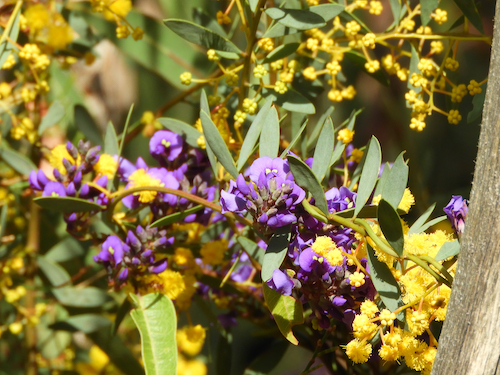
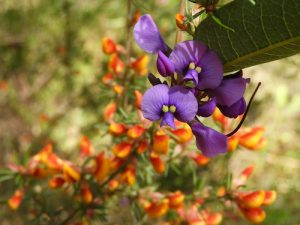
Swathes of colour were provided by Hardenbergia violacea contrasting with the bright yellow and orange of acacias and the Pultenaea flowers.
A diligent and slow walk commenced to the caves. Delegates soon spotted Chloanthes parviflora and Dampiera lanceolata (Grooved Dampiera). We saw the common shrub Dodonaea viscosa subsp. cuneata (Sticky Hop Bush). Boronia glabra was soon seen and was flowering nicely. Acacia gladiiformis (Sword Wattle) was numerous but coming to the end of its flowering. Acacia pravifolia (Coil-Pod Wattle; a much smaller plant) was present in good numbers and in flower. Acacia decora (Western Silver Wattle) was often with us…in full flower.
Another eye-catcher was Stypandra glauca (Nodding Blue-Lily), which was in full-flower, brightening up the track. Styphelia triflora (Pink Five Corners) also attracted interest as did Melichrus urceolatus (Urn Heath). We also saw Grevillea triternata and another very interesting one was Ricinocarpos bowmanii (Western Wedding Bush). Member Wendy Grimm was also hunting orchids; Wendy identified Diuris goonooensis (Western Donkey Orchid).

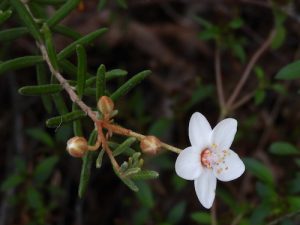
Styphelia triflora (Pink Five Corners) and Ricinocarpos bowmanii (Western Wedding Bush).
Near the caves, a gorgeous mint bush was flowering in good numbers. This turned out to be Prostanthera granitica (Granite Mintbush) (yes…on sandstone substrate)…but common in the area. Bursaria spinosa (Native Blackthorn) was also here as was Phebalium squamulosum (Scale Phebalium). Wendy pointed out Caladenia fuscata (Dusky Fingers) and C. caerulea (Eastern Blue Fingers).

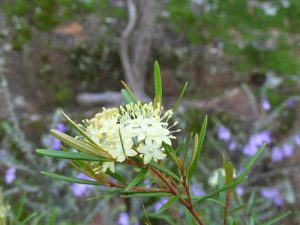
Prostanthera granitica (Granite Mintbush) and Phebalium squamulosum (Scaly Phebalium).
Our next botanising spot was a lunch-stop on the side of Barradine Rd (with the Warrumbungles towering in the distance) in some pure Eucalyptus albens (White Box) country. This tree is dominant over most areas in this general part of the State, on the heavier soils, and it is easily identifiable. Some trees were hosting two or more species of mistletoe. One was probably Amyema miquelii (Box Mistletoe) with its tear-drop habit; no flowers, but plenty of fruit. We quickly reviewed a few plants present; such as Clematis microphylla (Small-leaved Clematis), Eremophila debilis (Winter Apple), Indigofera australis (Australian Idigo) and Ajuga australis (Austral Bugle). Delegates were very interested in Geijera parviflora (Wilga) – a Rutaceae tree which occurs in large numbers in this country, frequently growing at the base of trees.
The afternoon was spent at Bilby Blooms Nursery where Anthony and Annabelle O’Halloran gave us a great tour (and afternoon tea) with a lot of enthusiasm. Anthony showcased many plants such as hakeas, grevilleas and others and also confirmed our earlier plant identifications.
Annabelle pointed out a remnant Eucalyptus blakelyi (Blakely’s Red Gum) and a planted Acacia covenyi (Blue Bush). Delegates were able to purchase plants. Dan purchased 2 x Ajuga australis plus Prostanthera ‘Dunedoo’; an as-yet undescribed species while Ralph got three more assorted Hakeas and eremophilas for his new garden. Others on the coach also left with specimens to take home. Some of their showiest specimens were Eucalyptus youngiana (Large-fruited Mallee) and E. pachyphylla (Red-budded Mallee), both with their spectacularly large fruit and buds; and Kennedia retrorsa – with purple-pea flowers; a plant that may be close to extinction in the wild.
Tuesday morning, we took off to Warrumbungle NP. First walk was a short one to White Gum Lookout. This area has undergone a severe fire in 2013 and is still recovering. We were a bit perplexed as to what the actual ‘White Gums’ were. There was plenty of White Box and also plenty of white Inland Scribbly Gum (Eucalyptus rossii). So, we decided they must be it(?). Eucalyptus mannifera (Manna Gum) may have been here as well. Angophora floribunda (Rough-barked Apple) was also common here. We saw Indigofera australis (Native Indigo – looking very different to the Sydney forms) and compared it to Swainsona sp. (likely S. galegifolia). A good sighting and learning opportunity was Alstonia constricta (Bitter Bark / Quinine Tree) – a rainforest relic – which was growing along the track edges. Some epacrids were present; namely Styphelia triflora as well as Melichrus erubescens (Ruby Urn Heath) with red flowers.


Melichrus erubescens (Ruby Urn Heath) with red flowers and Wurmbea dioica (Early Nancy).
Dan found a bizarre plant at the lookout, a soft spreading shrub with large-crinkled blue leaves. It turned out to be Muehlenbeckia rhyticarya (Wrinkle-nut Lignum). Hardenbergia violacea (Purple Coral-Pea) was also stunning here as was Hovea lanceolata. Delegates also latched onto Wurmbea dioica (Early Nancy) which was numerous. Wendy pointed out Pterostylis mutica (Midget Greenwood) and Caladenia parva / atrovespa (previously C. tentaculata).
From here, a quick stop at the very nice Visitor’s Centre (with Ajuga australis pretty much growing at the front door) and then morning tea, where we studied Callitris glaucophylla (White Cypress Pine) and then to Burbie Canyon and Creek. This was a beautiful walk along a riparian corridor. The creek was flowing and the vegetation very green from generous rainfall over the last few years. We heard several Pobble Bonk frogs (Limnodynastes dumerilii) calling and found a Goanna up a tree.
Again – White Box and Rough-barked Apple were dominant with a shrubby and grass + herb ground layer. We saw Acacia cheelii (Motherumbah), in full bloom – a tree-wattle with its rod inflorescences. Small climbers such as Glycine clandestina were very showy. Delegates learnt Notelaea microcarpa – a very common Notelaea in this part of the State. Wendy also picked up Calytrix tetragona as well as Pittosporum angustifolium (Weeping Pittosporum) with its yellow flowers. Prostanthera rotundifolia (Round-leaved Mintbush) was also showy.
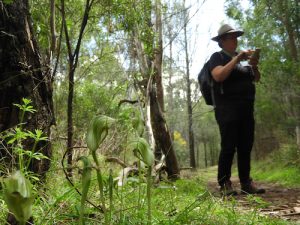
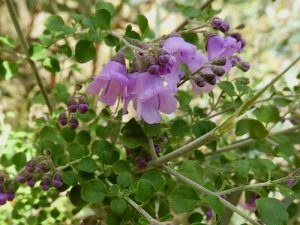
Pterostylis curta and Prosanthera rotundifolia
A showy and numerous wattle was Acacia paradoxa (Kangaroo Thorn). There was plenty of Microlaena stipoides (Weeping Grass) in the ground layer along with Echinopogon caespitosus (Echidna Grass). Correa reflexa (Native Fushcia) appeared as did Dodonaea viscosa subsp. angustifolia with its larger and stickier leaves, compared to subsp. cuneata. Even more sticky was Olearia elliptica (Sticky Daisy Bush), also common here. We were mystified by a Phyllanthus-shrub which looks as though it was P. subcrenulatus. There were also large Brachychiton populneus (Kurrajong). Pterostylis curta was also seen.
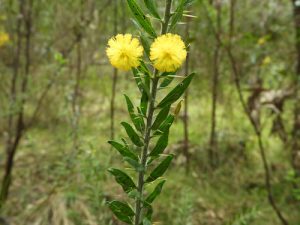
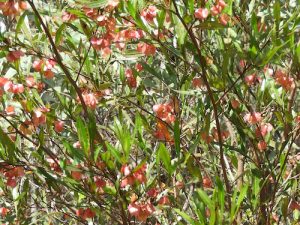
Acacia paradoxa (Kangaroo Thorn) and Dodonaea viscosa subsp. angustifolia
Wendy Grimm found some orchids again at the terminus of this walk in amongst some large sandstone boulders. Along here we also got Grevillea ramosissima (Fan Grevillea). This whole walk was a gorgeous area!
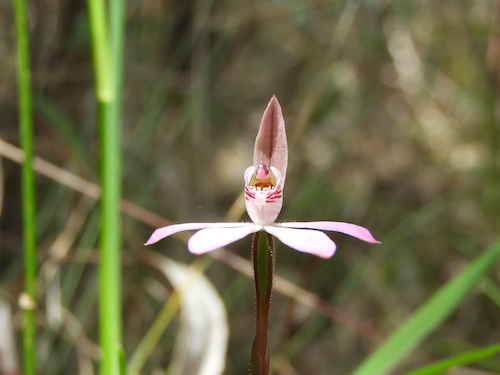
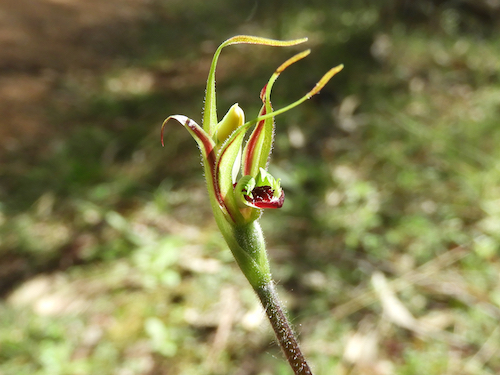
Caladenia fuscata and Caladenia parva
The next spot involved a power-walk up to Spireys View which we tackled in two hours. A bit hard to botanise but I found Acacia carolaea (Carol’s Wattle). Again, the vegetation followed a creekline and was in spectacular fashion – very green and moist. Seldom do we see it like this. Plenty of White Box. I collected a small specimen of the only Pomaderris, at a bridge, as well as a Malvaceae-looking item. I think they were Pomaderris prunifolia (Plum-leaf Pomaderris) and Seringia corollata respectively.
At Spireys, Wendy found some Caladenia major (Waxlip Orchid) and some Cyrtostylis reniformis (Gnat Orchid) back down the track. We powered back to the bus – very tired! But I found time to demonstrate the differences between two rock ferns, Cheilanthes sieberi (Poison Rock Fern) vs. C. distans (Bristly Cloak Fern), which were growing together along the track.
On Wednesday morning, we started out of Narrabri and headed to Sawn Rocks. This was also a beautiful short walk to this geological feature. Many of the same plants were seen but we saw some Sydney species such as Eustrephus latifolius (Wombat Berry) and Pandorea pandorana (Wonga Wonga Vine). There was also plenty of Oplismenus aemulus (Basket Grass) on the creekline at the rocks. Other new ones included Pimelea neoanglica (Poison Pimelea) with its yellow flowers. On the creekline, was Alectryon subdentatus which was interesting to see.
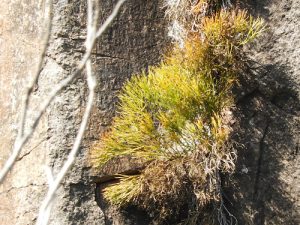
Most of us were interested in a yellow-green looking epiphytic plant growing high on the rocks. I thought it may have been an Exocarpos sp. but Wendy Grimm suggested Psilotum nudum (Skeleton Fork Fern). This is known to grow on the cliffs next to the Sydney Opera House but does extend west out to the Mt Kaputar area and it has been collected here. Very interesting! I took time, along the walk, to point out and discuss the dreaded weedy Coolatai Grass (*Hyparrhenia hirta) which is having a big ecological impact in this part of the State.
Later, we entered the University of Sydney Plant Breeding Institute near Narrabri. The information provided by A/Prof. Guy Roth and other staff on wheat and native grains was very interesting, especially learning that native grains were used extensively by First Nations Peoples and a big project is on to promote them in modern diets. We were keen to get to the bushland at the back of the block. This was a nice patch of Eucalyptus-Callitris Woodland, owned by the University, and has never been floristically surveyed. Here we saw Angophora leiocarpa, which, for those of us in coastal NSW, looks exactly like Angophora costata (Sydney Red Gum) but with smaller and ribless fruits. Delegates were very interested in Solanum cinereum (Narrawa Burr), a native solanum with showy purple flowers and thorns. We collected Mirbelia pungens (Prickly Mirbelia) as well as Pultenaea cinerascens. Other new ones here were Leucopogon biflorus. Shirley McLaran found Hovea apiculata. There was also an eye-catching Phebalium squamulosum subsp. gracile with its small leaves. Again, there was a lot of flowering Acacia cheelii with it’s distinctive bark.
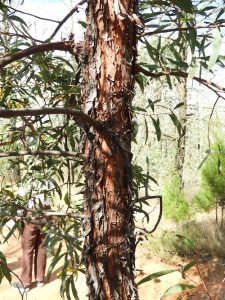
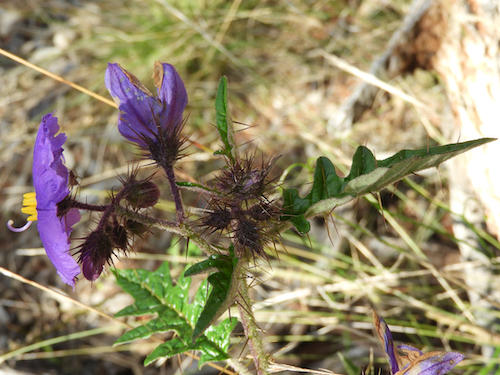
Acacia cheelii with its distinctive bark and Solanum cinereum (Narrawa Burr)
Later that evening, we travelled deep into the Pilliga, to the south-west of Narrabri and saw some spectacular flowering bushland close to sunset. We got the chance to do a bit of botanising outside and inside the Australian Wildlife Conservancy fenceline. We found Grevillea floribunda with its orange-brown inflorescences. Acacia spectabilis was dominating the show (as the name suggests) and another 3 wattles were determined: A. subulata (Awl-leaved Wattle), A. mariae (Golden-top Wattle) and A. havilandiorum (Needle Wattle).

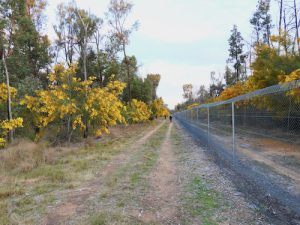
Acacia subulata (Awl-leaved Wattle) and acacias on the fenceline.
There was more Leucopogon biflorus along with Daviesia ulicifolia (Gorse Bitter Pea), and a strange little multi-branched shrub with pinnate leaves was identified as Gompholobium foliolosum. We drove out in the dark.
Thursday morning saw us on our way to Dubbo and Orange. Unfortunately, it rained on this day. We did take in the Wellington Caves Complex for lunch and strolled through the small Japanese Gardens there. These gardens have incorporated large trees of Eucalyptus melliodora (Yellow Box). At Orange, the rain interfered with our appointment at Mt Canobolas. So, in the dining room of the motel, I held a quick crash-course and review of the plant specimens we had come across. Some of us later chose to take a walk, in the light rain, in Cook Park where we got hands on with two trees which have been planted here; namely *Sequoia sempervirens (Coast Redwood; the world’s tallest tree-species) and *Sequioadendron giganteum (Giant Redwood; not the world’s tallest but considered the heaviest organism). The foliage of the two is very different.
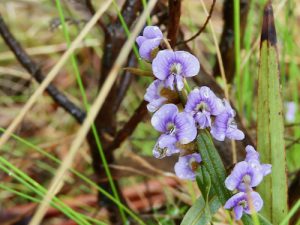

Hovea heterophylla and the tour group
Next morning, we could not quite get up to the top of Mt Canobolas but we got most of the way and did some botanising in some nice montane woodland. Here we looked at trees of Eucalyptus dalrympleana (Mountain Gum) with its buds and fruits in 3s, and E. dives (Broad-leaved Peppermint) with its distinctive juvenile leaves smelling very strongly of peppermint. We discussed the presence of Eucalyptus canobolas, a threatened eucalypt that Helena Rendell mentioned was at this location. It is only found on Mt Canobolas and was previously a subspecies of E. rubida. We did not really have time to find it on the higher ground. Leucopogon attenuatus was growing on the rocky outcrops. Hovea heterophylla was also sighted. Shirley McLaran pointed out potentially Pultenaea setulosa.
The tour was very enjoyable with extensive plants to see and learn, especially given the time of year and recent rains.
The delegates were a fantastic bunch of interested plant lovers; and the locations were well-worth seeing in the current conditions.
